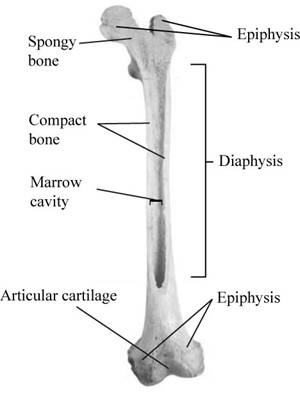
To label:
A limb bone, such as the tibia and to show the regions of articular cartilage, spongy trabecular bone, compact bone tissue, and the marrow cavity.
Introduction:
The long bone consists of two parts: diaphysis and epiphysis. The epiphysis is the wider region at the ends of the bone, whereas, the shaft like structure residing between the two ends of the bone is called diaphysis.
Explanation of Solution
Pictorial representation:

Fig.1: The parts of the tibia bone.
The outer layer of the bone is referred to as the compact bone. It is composed of the dense tissues (osteocytes). The inside of the bone is composed of same osteocytes, but they are not arranged in an organized manner as in the compact tissue. This results in the spongy trabecular tissue.
The periosteum is the fibrous membrane that covers the outer region of the bone. This membrane has the important nerve cells and the blood vessels that supply nutrition to the compact bone. The ligaments and the tendons are attached to the periosteum of the bone. The periosteum is not present at the region of the epiphysis (linkage of bones to bones). The area at which the periosteum is absent, the articular cartilage is present, which provides resistance to friction.
The marrow content is present in the void space of the diaphysis of the bone. The marrow cavity has a thin layer of endosteum. The growth, repairing and fixing of bones takes place in endosteum.
The structure of bone includes marrow cavity, trabecular tissue, articular cartilage, and compact bone. The bone is divided into two parts epiphysis and diaphysis.
Want to see more full solutions like this?
Chapter 35 Solutions
BIOLOGY HOW LIFE WORKS & ACHIEVE FOR BIO
 Human Anatomy & Physiology (11th Edition)BiologyISBN:9780134580999Author:Elaine N. Marieb, Katja N. HoehnPublisher:PEARSON
Human Anatomy & Physiology (11th Edition)BiologyISBN:9780134580999Author:Elaine N. Marieb, Katja N. HoehnPublisher:PEARSON Biology 2eBiologyISBN:9781947172517Author:Matthew Douglas, Jung Choi, Mary Ann ClarkPublisher:OpenStax
Biology 2eBiologyISBN:9781947172517Author:Matthew Douglas, Jung Choi, Mary Ann ClarkPublisher:OpenStax Anatomy & PhysiologyBiologyISBN:9781259398629Author:McKinley, Michael P., O'loughlin, Valerie Dean, Bidle, Theresa StouterPublisher:Mcgraw Hill Education,
Anatomy & PhysiologyBiologyISBN:9781259398629Author:McKinley, Michael P., O'loughlin, Valerie Dean, Bidle, Theresa StouterPublisher:Mcgraw Hill Education, Molecular Biology of the Cell (Sixth Edition)BiologyISBN:9780815344322Author:Bruce Alberts, Alexander D. Johnson, Julian Lewis, David Morgan, Martin Raff, Keith Roberts, Peter WalterPublisher:W. W. Norton & Company
Molecular Biology of the Cell (Sixth Edition)BiologyISBN:9780815344322Author:Bruce Alberts, Alexander D. Johnson, Julian Lewis, David Morgan, Martin Raff, Keith Roberts, Peter WalterPublisher:W. W. Norton & Company Laboratory Manual For Human Anatomy & PhysiologyBiologyISBN:9781260159363Author:Martin, Terry R., Prentice-craver, CynthiaPublisher:McGraw-Hill Publishing Co.
Laboratory Manual For Human Anatomy & PhysiologyBiologyISBN:9781260159363Author:Martin, Terry R., Prentice-craver, CynthiaPublisher:McGraw-Hill Publishing Co. Inquiry Into Life (16th Edition)BiologyISBN:9781260231700Author:Sylvia S. Mader, Michael WindelspechtPublisher:McGraw Hill Education
Inquiry Into Life (16th Edition)BiologyISBN:9781260231700Author:Sylvia S. Mader, Michael WindelspechtPublisher:McGraw Hill Education





